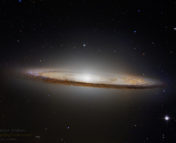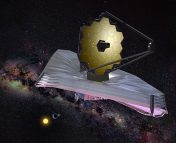Title: A Cold, Massive, Rotating Disk Galaxy 1.5 Billion Years after the Big Bang
Authors: Marcel Neeleman, J. Xavier Prochaska, Nissim Kanekar, Marc Rafelski
First Author’s Institution: Max-Planck-Institute of Astronomy, Heidelberg, Germany
Status: Published in Nature [open access on arXiv]
The birth of disk galaxies
The Milky Way, the galaxy we call home, has a distinguishable disk-shaped structure in its center. We refer to this type of galaxy as a disk galaxy. Billions of massive galaxies with similar morphology to our Milky Way exist, and astronomers believe that these disk-like siblings are born in the same way, i.e., through the continuous merging of dark matter halos.
When dark matter halos merge, the gas and dark matter within the halos condense into larger structures. In some dense regions, stars are born from collapsing gas, and the galaxy starts forming (See Figure 1). However, details about this process are still uncertain. This is because different physical processes have different efficiency of converting falling mass into luminosity, which results in different timescales.
Therefore, it is important to push the observing limit to search for the earliest disk galaxies, in order to put a constraint on the formation time and explore the actual physical process.
Within the constraints of current technology, in today’s paper, the authors aim at discovering the oldest and farthest disk galaxy by using the Karl G. Jansky Very Large Array (VLA) and Atacama Large Millimetre/submillimetre Array (ALMA), which may shed some light on disk galaxy formation.

The oldest and farthest discovered disk galaxy
The major challenge in observing the earliest galaxies at high redshift is the low resolution and sensitivity of telescopes. These limits result in a bias towards the most luminous sources like quasars, with dense environments and strong emissions from active star formation. However, if the galaxy happens to lie in front of a quasar at high redshift, the emissions from the quasar will be absorbed by the galaxy. By studying these absorption features, astronomers are able to trace and discover the disk galaxies without detecting the actual dynamics of the gas.
The authors first notice some velocity change in the [C II] line emission. This feature is common among gaseous absorbers, like a disk galaxy along the line of sight. Using ALMA, they identified the intervening observer, named DLA0817g, with strong [C II] emission sitting right in front of a quasar!
After locating the source of the [C II] line, the authors examine specific attributions of DLA0817g that would give rise to the emission feature. In other words, is the contributor a rotating galactic disk which might indicate a disk galaxy at such high redshift, or is it just dust and stars in a common absorber? In order to answer this question, the authors conduct more observations and theoretical simulations.
Observationally, the authors use ALMA to sketch the velocity profile of DLA0817g (Figure 2A), which is consistent with disk galaxies. They also derive a position-velocity (p-v) diagram of the absorber (Figure 2B). The p-v diagram shows a characteristic S-shape, which is the proto-typical signature of a rotating disk with a constant rotational velocity.
Theoretically, the authors’ simulations suggest the existence of a stable rotating gaseous disk in DLA0817g. By individually fitting [C II] emissions produced by dust, stars, and the gaseous disk, to a Hubble Space Telescope image in addition to ALMA observations, they find the emissions most likely come from a smooth disk instead of other contributors.
Therefore, the authors conclude that DLA0817g at z = 4.26 is not only a disk galaxy but also the oldest and farthest one ever discovered, only 1.5 billion years younger than the universe!

Were the disk galaxies cooked in an oven or not?
How does DLA0817g, the oldest and farthest sibling of the Milky Way, discovered thus far in the big family of disk galaxies, help with our understanding of disk formation?
There are two main theories regarding the physical process of disk formation.
The first one is ‘hot mode’ accretion. Infalling gas is heated by shock and accretes spherically. The temperature reaches the virial temperature, the average temperature to maintain equivalence in the gravitational system. Then, the system cools down and forms a rotating disk in the central region. In this process, the accretion efficiency is very low. Therefore, it takes a long cooling period for gas to condense into the disk. As a result, disk galaxies would form around z < 1.
The competing theory is ‘cold mode’ accretion. Instead of heating and condensing, gas takes advantage of filamentary structures or galaxy mergers to directly flow into the galaxy. In this way, the accretion is very efficient and most gas is able to remain cold, significantly below the virial temperature of the galaxy. Hence, the system requires no cool down period. The disk can appear very early, even in the childhood of the universe – a short time after the Big Bang (around z=5).
There is a clear time contrast as well as different gas phases between two theories. This is where DLA0817g comes in.
DLA0817g was formed when the universe was only ~10% of its current age! Also, based on VLA observations, cold molecular gas makes up a large proportion of DLA0817g. The authors find that the short timeframe and the cold dense gas both favor the “cold mode” of galaxy formation.
The authors add that galaxies like DLA0817g and its associated quasar are common systems at high redshift. By using a similar approach, they expect to find more old galaxies at similar redshift, and further verify other uncertain details about galaxy formation in the future.
Banner picture Credit: NRAO/AUI/NSF, S. Dagnello





Helllo Mrs Yan.
You state: “…only 1.5 billion years younger than the universe!”
Do you mean older than?
Regards from Germany
Charlyms
Thanks for the comment. Everything in the universe has to be born after the universe. So it is younger.